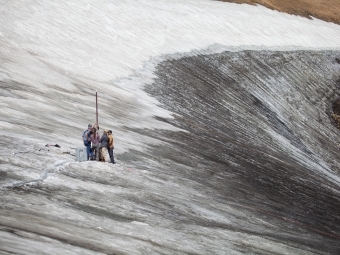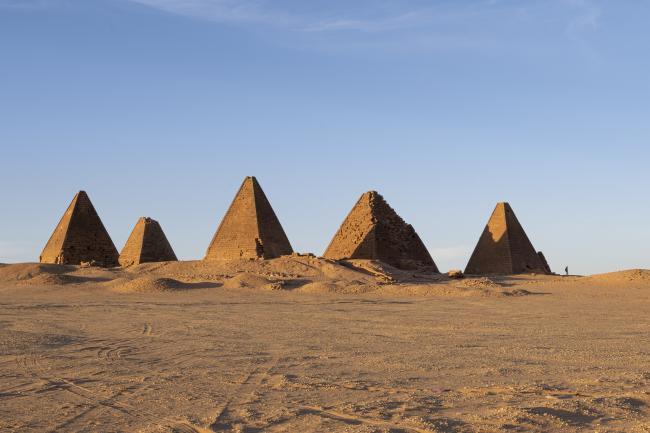Going Places: Journey Around the World With Photographer and Archeologist Matt Stirn '11
July 20, 2021
- Author
- Lisa Patterson

A large North Atlantic storm approaches the charismatic lighthouse at Peggy’s Cove, Nova Scotia.
Stirn’s unique career combines his love of nature, skills as an archeologist and paleoecologist, and eye for a story. The work takes him all over the world, from the jungles of Sumatra to little-explored, harsh Alpine landscapes.
Gunung Leuser National Park, Sumatra, Indonesia

A female orangutan peeks from behind a fig tree branch. Stirn had been hiking in the mountains of Sumatra and came face to face with this orangutan as he turned a blind corner in the trail.
As the rainstorm approached, the orangutan mother deftly wove an umbrella out of leaves to hold over her newborn’s head.
Then the rain began to pour down. Matt Stirn ’11 watched in fascination, camera poised. That endangered wild orangutan family figures into Stirn’s most cherished memories, a bank of recollections the most seasoned adventurer would envy.
Nubian Pyramids & The People of Sudan

Sudanese students play and relax amongst pyramids at Meroë, the royal necropolis of the Kingdom of Kush. The Kushites once ruled over Nubia in modern day Sudan, built more pyramids than the Egyptians, and successfully conquered Egypt to rule over the Nile.
Matt Stirn started digging archeology at age 12, though, when his parents arranged for him to volunteer for an afternoon with a team from the University of Wyoming that was excavating a 10,000-year-old campsite near his middle school. That afternoon turned into two weeks of work at the site, which subsequently transformed into a 20-year vocation.
[Right] Medina, a 100-year-old Nomad sits in her canvas tent deep in Sudan’s Bayuda desert. During our visit over cardamom spiced Sudanese coffee, she spoke about life in the desert, when the first roads were built through her family’s territory, and concerns about changing climate patterns in her remote corner of the Sahara.
[Left] Lightpainting of a pyramid of an unknown king at the royal Kushite necropolis of Meroë. This cemetery, used between 350BC to 300AD, contains over fifty pyramids and served as the necropolis for the capital city. The pyramids are a UNESCO World Heritage site and receive only 200-300 visitors a month. Local administrators and tour operators hope that following the 2019 revolution, people will become more willing to travel to Sudan and provide a new economy centered upon tourism and heritage preservation.
Photographed in January 2020 for a story in Smithsonian Magazine about modern Nubia's deep connection to the ancient Kingdom of Kush and how following the 2019 Sudanese revolution the region is hoping to open its doors to tourism.
Beartooth Mountains & Jackson Hole

A team of archaeologists, geologists and climate specialists use a drill to extract an ice core from a glacier along Wyoming’s Continental Divide. The multidisciplinary team will extract pollen from the ice to help reconstruct ancient climates and map the ebb and flow of alpine ice over the past 10,000 years.
Stirn’s connection to the natural world stems from life spent on a ranch in Jackson Hole, Wyoming—his great-grandparents established the land as one of the first conservation easements in the region, forever protecting it from development. He recalls this “wildlife paradise,” where herds of elk, moose, bears, eagles and wolves were a part of daily life. When he’s not traveling, he splits his time between an apartment in Boston and the Wyoming ranch.
As a journalist, he aims to bridge the gap between scientific information and the public. “Every time I can publish an archaeological story in a place that normally doesn’t feature such topics, I call it a minor victory,” he says. “If I can get people who typically don’t think about archaeology or science to stop for a moment, look deeply at a picture, and become intrigued about scientific discovery, history, or conservation, I’ve accomplished everything I set out to do.”

A large bull elk stands amongst vibrant fall foliage on the R Lazy S. At any time of the year, dozens of animals, such as elk, moose, grizzly bears, coyotes and wolves, can be found roaming the aspen groves and river bottoms of the ranch.
This article was originally published in the Spring/Summer 2021 print issue of the Davidson Journal Magazine; for more, please see the Davidson Journal section of our website.














